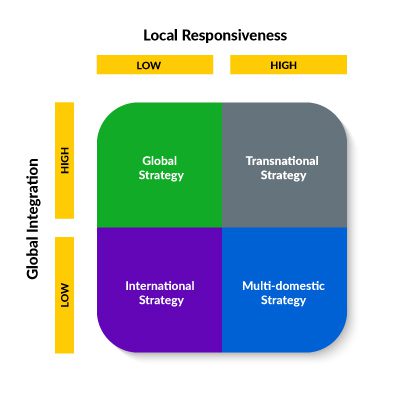As a company considers expanding to new markets, international business strategies must be put in place for that plan to be effective. This is the first installment of an international business strategies series that will take a deep dive into translational, multi-domestic, global, and international strategies used to target new markets within international borders.
All the strategies mentioned above require a specific level of commitment around four main factors. Those factors are local responsiveness, global integration, standardization, and customization.
Understanding the Four Global Business Strategy Pillars
Before determining the best approach for global expansion, it’s important to understand the four primary global business strategy pillars:
Local Responsiveness
Local responsiveness refers to a company that localizes its products and services to meet conditions and nuances in other countries.
Global Integration
Global integration refers to a company’s local presence in the global market and the degree to which it can use the same products and services in other countries.
Standardization
Standardization refers to how a company does a “one size fits all” for the same products and services in other countries.
Customization
Customization refers to the process through which a standard message, procedure, or offering may be adapted according to the context or market in which it will be used.
A transnational strategy places equal importance on global integration and local responsiveness. This makes it an ideal strategy for companies that want to grow their global presence while ensuring they meet the needs of a multilingual, multicultural audience.
What is a Transnational Strategy

A transnational strategy leverages a high level of local responsiveness and a high level of global integration in its operations. It tries to localize its offering to each global market while also standardizing as much as possible. The goal of transnational strategies is to offer customized products and services for local markets while also keeping a high degree of standardization to benefit from economies of scale.
Transnational strategies typically involve large companies with different subsidiaries, branches, or offices across multiple global markets. The challenge is determining what stays the same across all global communications and procedures vs. where adaptations from local subsidiaries in global markets are adjusted or allowed. Finding the right balance between local responsiveness and global integration is going to be unique for every organization.
Companies spearheading a transnational strategy know when to allow global branches to adjust and make customizations and when not to. This means having clear directions on all international activities and operations.
There are several international business strategies to compare, here are a few examples:
- International Strategy – This is a strategy ranks low on global integration, low on local responsiveness and high on standardization. Companies that implement an international strategy disregard both costs and local cultural preferences. Apple is a good example; it sells standardized products globally without adjusting the model or price for each market.
- Multi-domestic Strategy – This is a strategy ranks high on local responsiveness but low on global integration. A multi-domestic strategy adapts to local responsiveness to satisfy the demands of domestic markets. Each country or market receives a customized version of a product.
- Transnational Strategy – This strategy is a combination of multi-domestic and international strategies. It leverages both a high level of local responsiveness and a high level of global integration. In this type of strategy, organizations attempt to benefit from the efficiencies generated from standardization, while at the same time leaning on global branches to localize aspects of their messaging and offerings to local preferences.
Why Use a Transnational Strategy?
A transnational strategy is best for companies operating in diverse international markets where both cost control and localization are critical. For example, global brands like Coca-Cola or McDonald’s standardize core products while customizing advertising, packaging, and messaging for local audiences.
This strategy enables your business to:
Compete on a global scale while respecting local norms.
Maintain brand consistency across regions.
Use centralized systems for cost efficiency.
Deliver a localized experience to boost relevance and customer trust.
Build a scalable global content strategy for multilingual audiences.
However, executing a transnational strategy takes more effort than other models. You must decide which elements to centralize and which to localize—from pricing to website translation to product features.
Developing a Transnational Strategy
Transnational businesses must operate through an organized network of subsidiaries across multiple countries. Each subsidiary needs to understand its local customers’ preferences and combine the resources provided by the head office to adapt products and services to local preferences.
With a proper transnational strategy, multinational corporations can leverage the benefits of standardization without sacrificing local responsiveness in different countries. They operate at a high level of communication, knowledge, and productivity to meet strategic objectives across various markets.
7 Steps to Develop a Transnational Strategy:
- Research the markets where you are planning to expand. It’s important to consider foreign policies, regulations, and logistics when identifying potential barriers to entry.
- Understand the nuances of the culture and the language; the same language can have different dialects, with differing meanings tied to the same words.
- Understand the local economy. This is crucial to identifying price points and preferences.
- Get to know the target market. The consumers of a product might differ across countries. By understanding potential customers, you can tailor your product or messaging to guarantee greater success.
- Analyze how much global integration and local responsiveness you need to be successful and stay competitive. This will help you determine the level of customization vs. standardization you will need to achieve with your messaging.
- Determine your translation approach by identifying the type of translation services you will need and the costs associated with your goals. You will need to ask how your organization will want to translate and present content in each market.
- The global economy changes daily. By creating an actionable plan to achieve your business goals, you can better determine how to stay agile in your global business strategy.
It’s crucial to understand that the strategies that may have worked in one market (or company) may not be successful in another. The more agile and receptive you are to buyer tendencies in different regions, the faster you can implement changes.
Transnational Strategies in the Digital World
Digital transformation adds new complexity to global expansion. Brands must provide consistent messaging while personalizing customer experiences across channels like websites, mobile apps, support portals, and social media.
To execute your transnational strategy successfully, you need technology that supports both scale and flexibility. A modern website translation solution can:
Centralize content management across regions.
Empower local teams to customize specific web pages or promotions.
Speed up translation without compromising quality.
Support SEO localization to drive global visibility.
Why Translation Powers Transnational Success
Language and cultural relevance are essential in connecting with global audiences. Companies that invest in high-quality multilingual content and website translation see stronger brand engagement and better ROI across international markets.
Your global content strategy must ensure that translated material aligns with local tone, style, and expectations. This goes beyond just words—it includes visuals, CTAs, legal requirements, and even payment methods.
Ready to Go Global? Let’s Make It Happen
With the right transnational strategy, you can enter new markets, connect with diverse global audiences, and drive sustainable growth worldwide. There are many approaches to start executing a successful transnational strategy—developing new brands, investing in localized marketing campaigns, and testing new products are some examples. But regardless of your go-to-market strategy, your company should seek to pursue robust translation workflow processes and high translation quality. Efficient communication will play a significant role in your success.
MotionPoint helps global brands launch, manage, and scale multilingual websites and customer experiences. Our adaptive translation technology supports your localization strategy while preserving global brand consistency.
Special Offer: When you launch one language (like Canadian French), we’ll give you a second language (like European French) free for a limited time. Let’s build your global presence—one market at a time.
Last updated on April 04, 2025

